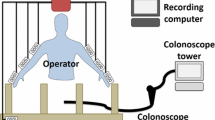Abstract
Purpose
To establish the construct validity of a semirigid ureteroscopy in a high-fidelity simulation model, incorporating hand motion analysis as a paramount part of evaluation.
Methods
Participants were divided into 3 groups: group 1 (9 junior residents, without experience in ureteroscopy), group II (9 senior residents, with variable experience in ureteroscopy) and group III (2 experts in endourologist); each group performed a single practice session in the high-fidelity bench model, which was previously prepared with small urinary stone phantom in the mid-ureter. Assessment was done using motion tracking device (ICSAD). Procedures were recorded in external vision and endoscopic vision and scored by two blinded evaluators using a Global Rating Scale and ureteral checklist (OSATS).
Results
Significant differences were observed in time taken, path length, numbers of movements, Global Rating Scale and checklist in favor of the experts group. Subanalysis demonstrated no relevant differences between groups II and III in general dexterity parameters except for the non-dominant hand, where experts showed a significant less number of movement (34 vs 221; p = 0.03) and path length (12.1 vs 45.1; p = 0.03). The interrater reliability of the GRS was excellent (0.81; p < 0.001), while for checklist ICC was moderate (0.45; p = 0.03).
Conclusions
The incorporation of ICSAD into the construct validity of this ureteroscopy model complements traditional methods used to achieve construct validity (OSATS). To our knowledge, this study is the first report using motion analysis as a tool for performance evaluation in a simulated endourological procedure.
Similar content being viewed by others
Notes
UroScopic Trainer®, Limbs and Thing, Bristol, UK.
References
Brehmer M, Tolley D (2002) Validation of a bench model for endoscopic surgery in the upper urinary tract. Eur Urol 42:175–179
Schout MB, Hendrikx AJ, Scherpbier AJ et al (2008) Update on training models in endourology: a qualitative systematic review of the literature between January 1980 and April 2008. Eur Urol 54:1247–1261
Olweny EO, Pearle MS (2011) Update on resident training models for ureteroscopy. Curr Urol Rep 12:115–120
van Hove PD, Tuijthof GJ, Verdaasdonk EG et al (2010) Objective assessment of technical surgical skills. Br J Surg 97:972–987
Matsumoto ED, Hamstra SJ, Radomski SB et al (2001) A novel approach to endourological training: training at the surgical skills center. J Urol 166:1261–1266
Matsumoto ED, Hamstra SJ, Radomski SB et al (2002) The effect of bench model fidelity on endourological skills: a randomized controlled study. J Urol 167:1243–1247
Ridgway PF, Ziprin P, Datta VK et al (2002) Laboratory-based validation of a novel suture technique for wound closure. Ann Plast Surg 49:291–296
Hayter MA, Friedman Z, Bould MD et al (2009) Validation of the Imperial College Surgical Assessment Device (ICSAD) for labour epidural placement. Can J Anaesth 56:419–426
Dosis A (2005) Synchronized video and motion analysis for the assessment of procedures in the operating theater. Arch Surg 140:293–299
Datta V, Mackay S, Mandalia M (2001) The use of electromagnetic motion tracking analysis to objectively measure open surgical skill in the laboratory—based model. J Am Coll Surg 195:479–485
Salvadó JA, Oyanedel F, Astroza G (2014) Development of a task—specific checklist for endoscopic reterolithotomy. Rev Chil Urol 79:39–43
Grantcharov T, Reznick R (2009) Training tomorrow’s surgeons: what are we looking for and how can achieve it? ANZ J Surg 79:104–107
Livingston E, Rege R (2005) Technical complications are rising as common duct exploration is becoming rare. J Am Coll Surg 201:426–433
Accreditation Council for Graduate Medical Education. ACGME Program Requirements for residency Education in Urology (2009) http://surgery.umc.edu/documents/professionals/residency/urology/UrologyProgramRequirements.pdf
Skolarikos A, Gravas S, Laguna MP et al (2011) Training in ureteroscopy: a critical appraisal of the literature. BJU Int 108:798–805
McGreevy JM (2005) The aviation paradigm and surgical education. J Am Coll Surg 201:110–117
Moulton CA, Regehr G, Mylopoulos M (2007) Slowing down when you should: a new model of expert judgment. Acad Med 82:S109–S116
Rosenbaum D (2009) Psychological foundation human motor control. Academic Press, London, pp 79–118
Aggarwal R, Grantcharov T, Moorthy K (2007) An evaluation of feasibility, validity and reliability of laparoscopic skills assessment in the operating room. Ann Surg 245:992–995
Brydges R, Sidhu R, Park J (2007) Construct validity of computer—assisted assessment: quantification of movement processes during vascular anastomosis on a live porcine model. Am J Surg 193:523–529
Bann SD, Khan MS, Darzi AW (2003) Measurement of surgical dexterity using motion analysis of simple bench task. World J Surg 27:390–394
Brydges R, Classen R, Larmer J (2006) Computer—assisted assessment of one—handed knot tying skills performed within various contexts: a construct validity study. Am J Surg 192:109–113
Conflict of interest
The authors declare that they have no conflict of interest.
Author information
Authors and Affiliations
Corresponding author
Rights and permissions
About this article
Cite this article
Salvadó, J.A., Oyanedel, F., Sepúlveda, S. et al. Validation of a high-fidelity model in ureteroscopy incorporating hand motion analysis. Int Urol Nephrol 47, 1265–1269 (2015). https://doi.org/10.1007/s11255-015-1023-z
Received:
Accepted:
Published:
Issue Date:
DOI: https://doi.org/10.1007/s11255-015-1023-z




